In this blogpost, I would like to tell how the first days, weeks and months with our former street dogs went.
The first part of the story, from finding Tia to their day of departure to Germany, can be read here.
The second part of the story starts with the first eye-blink the morning after their arrival in Germany.

Tia and Sandy’s beds were draped in the living room. If possible, the dogs don’t sleep in the bedroom, as wet snouts in our faces and tripping dog paws on the floor, disturb our sleep.
However, since it was their first night in their new home, we left the doors open, so the dogs could decide for themselves where to sleep. They chose their beds in the living room and so we were able to close the bedroom door from the second night on.
Already the night before, the two fell into a deep sleep, because of exhaustion. The night was completely calm. No barking, no crying, no rioting. Togetherness helps a lot.
When I got up in the morning, they were both in their beds looking at me a little skeptically. They had no idea what our daily routine would be like. They also weren’t sure, if I was friend or foe. So, they remained seated and waited until I addressed them. I squatted down with some distance to their beds and spoke sweetly to them. Sandy staggered to me in a placating posture, smacking and licking herself, pinching her tail and waiting for petting.
Tia showed no signs of appeasement, but sniffed cautiously at my hand and then inspected the apartment. After they both shed their over-cautiousness and loosened up a bit, I put on their safety harnesses and walked them into the woods, next to our accommodation.
Since both dogs were very poorly muscled and Sandy’s appearance resembled that of a burn-out patient, we walked for a maximum of 30 minutes at a time, during the first weeks and let the dogs set the pace.
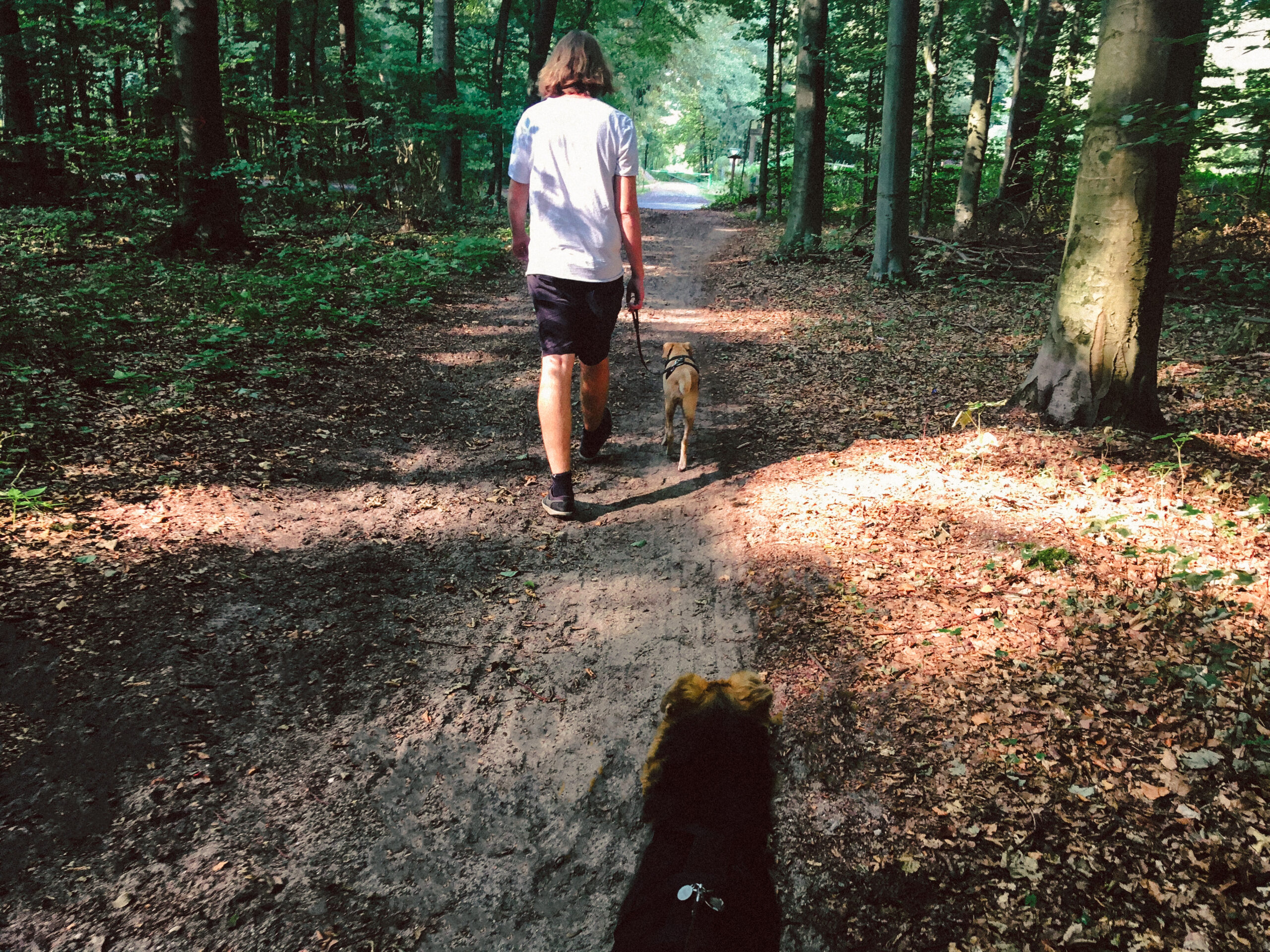
In Cyprus, the dogs lived quite secluded in houses in the countryside. They didn’t know the city life, crowds, traffic noise and countless dog encounters. So I needed to wait which reactions they showed.
I also decided not to drive during the first two weeks and to let the walks take place in the forest, next to our accommodation. Staying alone was also not planned during the first weeks. Only when they have settled and the rest works, we would start practicing it.
Tia and Sandy walked very carefully on the leash, next to or behind me, during the first days. They sniffed the area timidly. Other dogs were not noticed at first.
Unfamiliar people, however, were barked and growled at by Tia. Sometimes she hid behind me growling. Sometimes she hung fully in the leash and bared her teeth. Sometimes she jumped in the direction of cyclists. Sometimes she wanted to chase children on roller skates.
Since I am a fan of clear communication between man and dog, I immediately told her, that such reactions would not be tolerated.
If she hid behind me, I ignored her emotionally, positioned her next to me and gave her something to do. She should get the feeling that there are more important things than hiding. Moving forward, for example.
If she acted aggressively, she was brought back into position with a firm voice and, if necessary, with physical effort, by pushing her away from the front. Then she got something to do. Sitting for example, means time-out or the demand to remain passive, until today.
People who wanted to stroke or tried to appease the dog, were sent away. Tia should learn that she is completely uninteresting for strangers and that nobody wants anything from her. That no one paid attention to her, when she didn’t.
Since Tia’s reactions grounded in fear, I had to be very careful about the energy I approached her with. Under no circumstances should she associate my negative reaction to her behavior with the person who approached. She should relate my reaction to her behavior, which required fine-tuning and proper timing. However, she should definitely relate my positive reactions to other people. I praised calm behavior within sight of other people in a sugar-coated voice.
It was important to me, that she felt being seen and not having to go through the situation alone. It was also important to me, that she knew she was allowed to show a confident reluctance. That panic is just an unnecessary waste of energy and aggression is completely undesirable. Now falls the frowned upon the word dominance, which is so often misunderstood and equated with domination over every blink the dog takes.
The dominance I exercise is intended to open up the greatest possible freedom for the dog. I want my dogs to be able to move through the environment without a leash. To take on certain responsibilities. To think before they make decisions, and to feel, that they are independent beings in a safe environment, not fully controlled ones.
I establish all this by clearly pronouncing rules to which all members of the family must adhere, including me. I demand these rules very consistently. They can be briefly described as respectful behavior, which is universal for humans and animals.
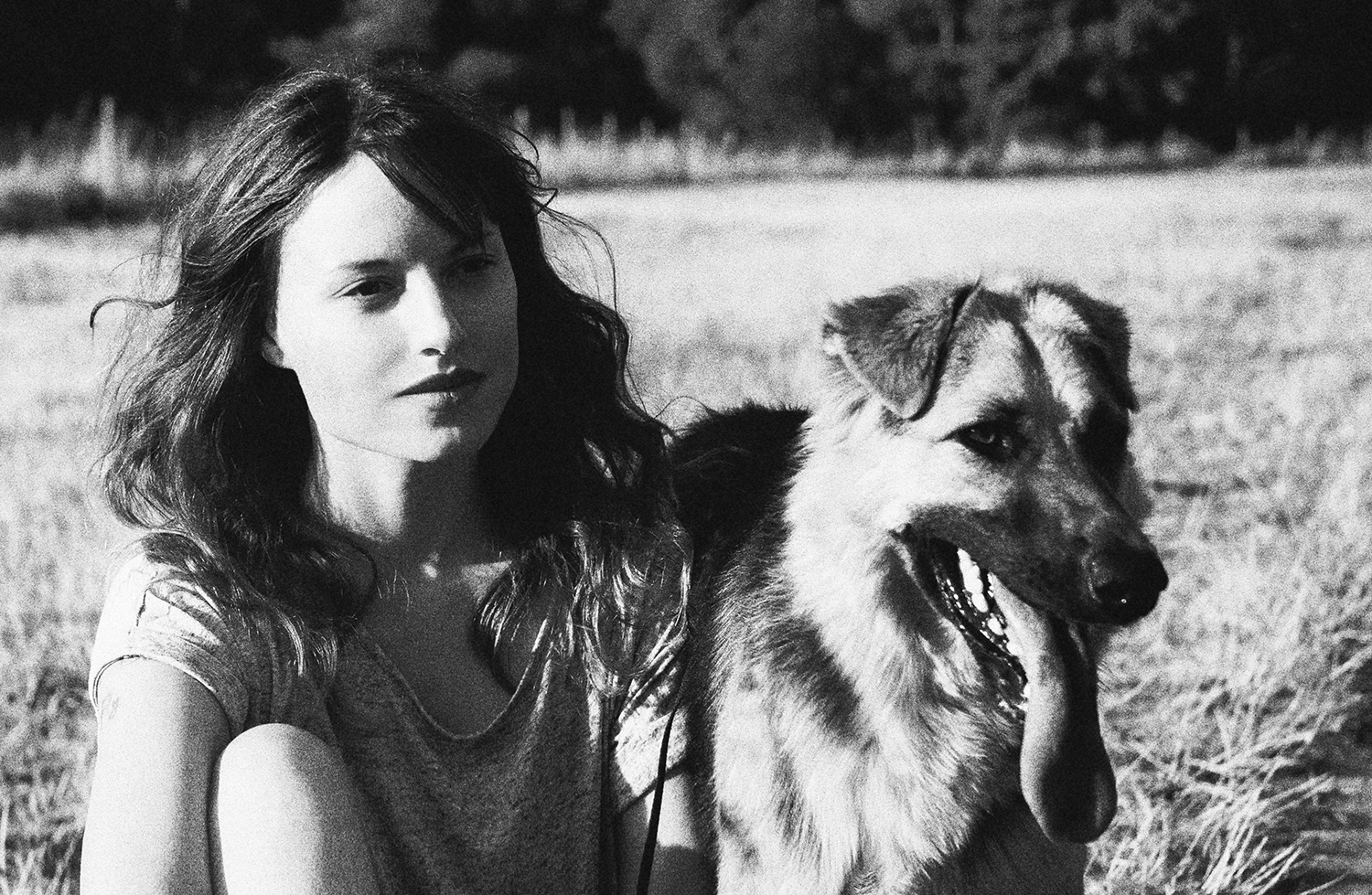
It is quite simple:
What your best buddy is not allowed to do, the dog is not allowed to do either.
Shouting, pushing, pinching, staring, begging, scolding, stealing food, tearing blouses, destroying furniture and also jealousy dramas is taboo for me. All behaviors I don’t like in humans, I also don’t like in dogs. I communicate with dogs in the same way I communicate with people. Not with the same words, but with the same energy and body language. Dogs understand this, just as humans do.
The prerequisite is, of course, that the dog’s needs are met and that the behavior is not a desperate cry for help, but is really based on disrespect or not knowing it better. A desperately bored dog without exercise and task, has my fullest understanding to disassemble the living room. I even ask him to. How else is he supposed to make a point?
It took two days and Tia’s bleating was history.
From the third day on, she walked on the leash just fine and I put on the tow-line on, to establish recall and give them a larger radius.
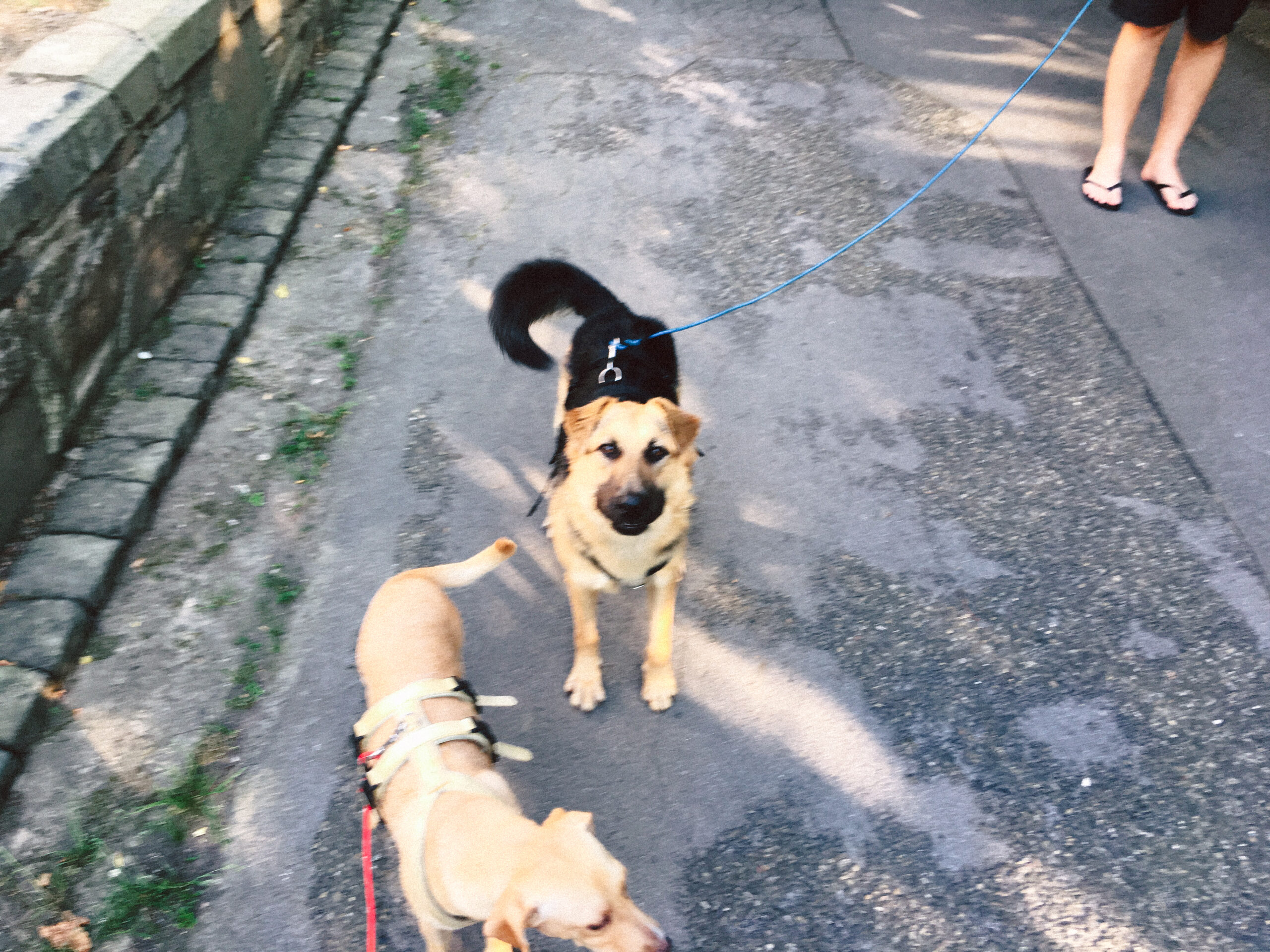

On the fifth day, the line tore the skin off my ankle, after the dogs darted around and it wrapped around my leg.
You’ll read why the end of a drag line should always be held in the hand and what my leg looked like after the accident, in one of my next blogposts.

On the same day, Sandy gnawed through her custom-made safety harness during the walk and thus decided to wear collar only. Not possible on tow-line, of course, so had to buy a harness from the pet store.
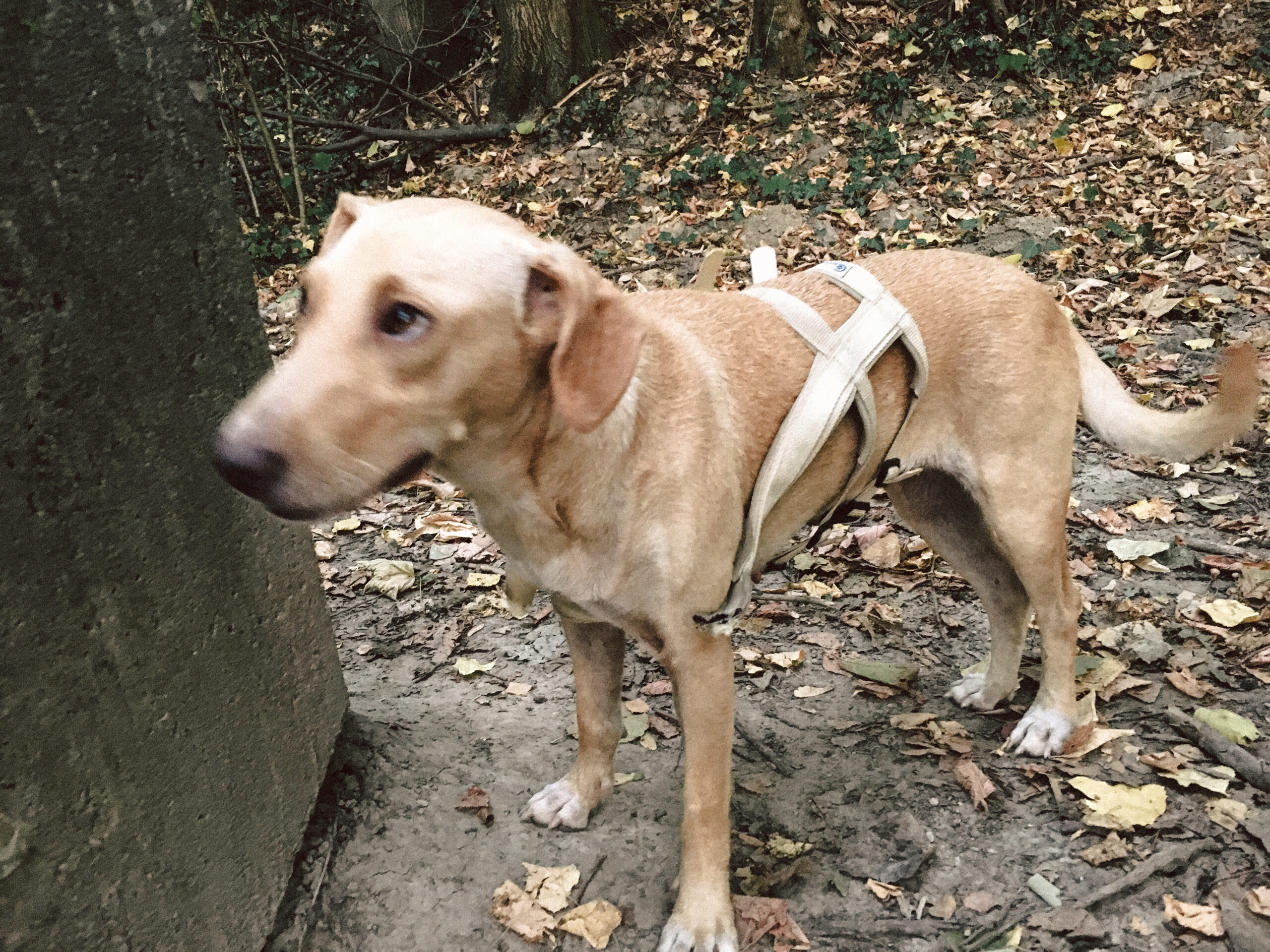
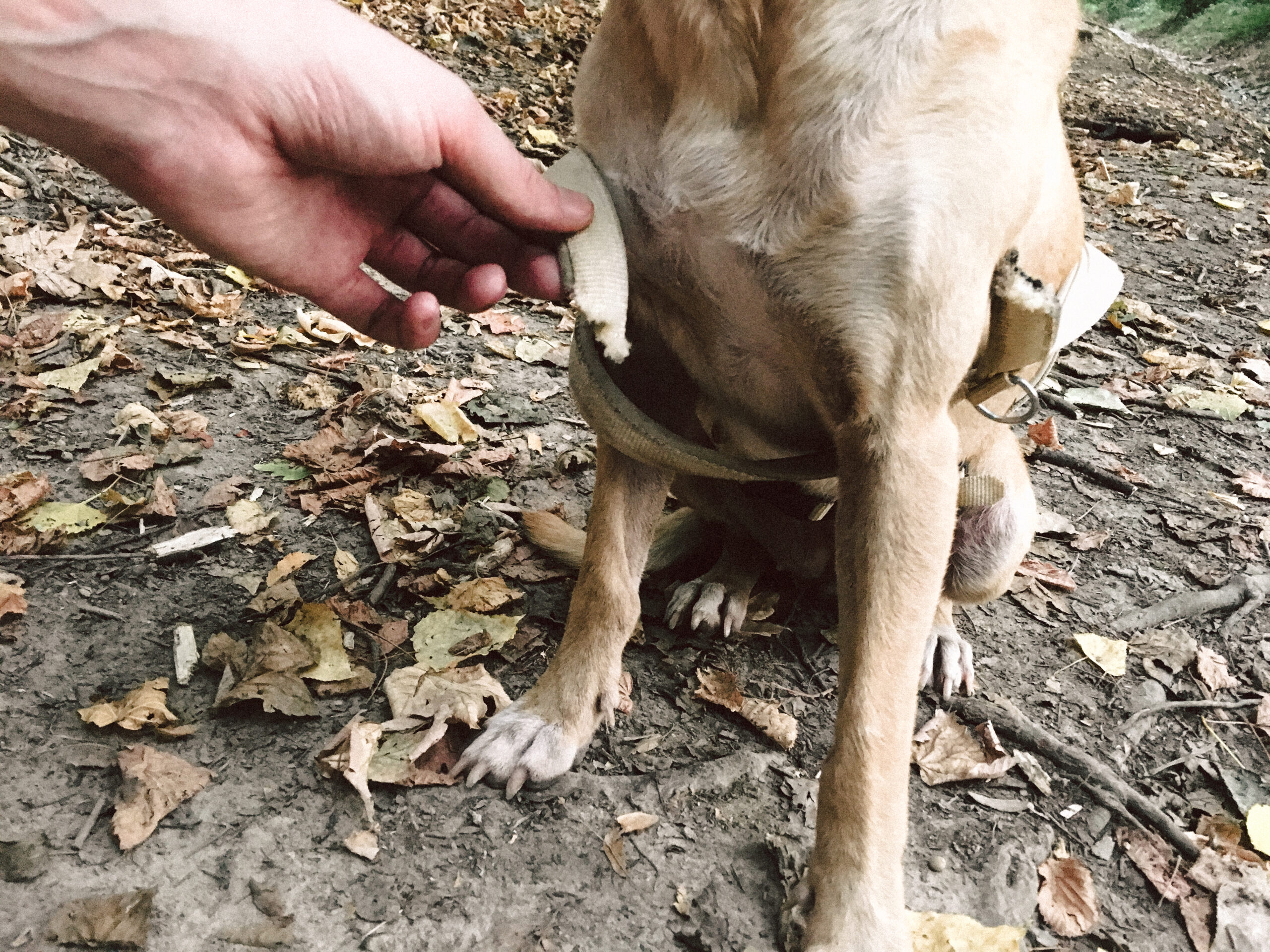
At the end of the first week, we were all already such a welded team, that I unleashed Tia and Sandy in our little forest. We had no yard and their need for free exercise was huge.
Normally, I didn’t advocate for such an early unleashing. However, with Tia and Sandy it was as if we had always been out together. They blended into the family so wonderfully after a few days, they listened to any word and made so many right decisions for us as a walking pack, that trust in them became unshakable quite quickly. Since I was only walking on one leg, due to my drag-line injury, my dogs’ newfound independence suited me just fine.
The famous invisible bond, which allows man and dog to communicate silently with each other, appeared in no time. It was, as if we simply belonged together or at least made a perfect fit.

And so it happened within only one week, Tia and Sandy were allowed to enjoy almost all the freedoms they still enjoy today. A say, a mostly leash-free life, and the freedom to take responsibility for their decisions and learn from their own mistakes. These privileges are based on our firmly established rules of respect, which ensure our safety and are consistently enforced. As smart creatures, they understood this principle with ease.
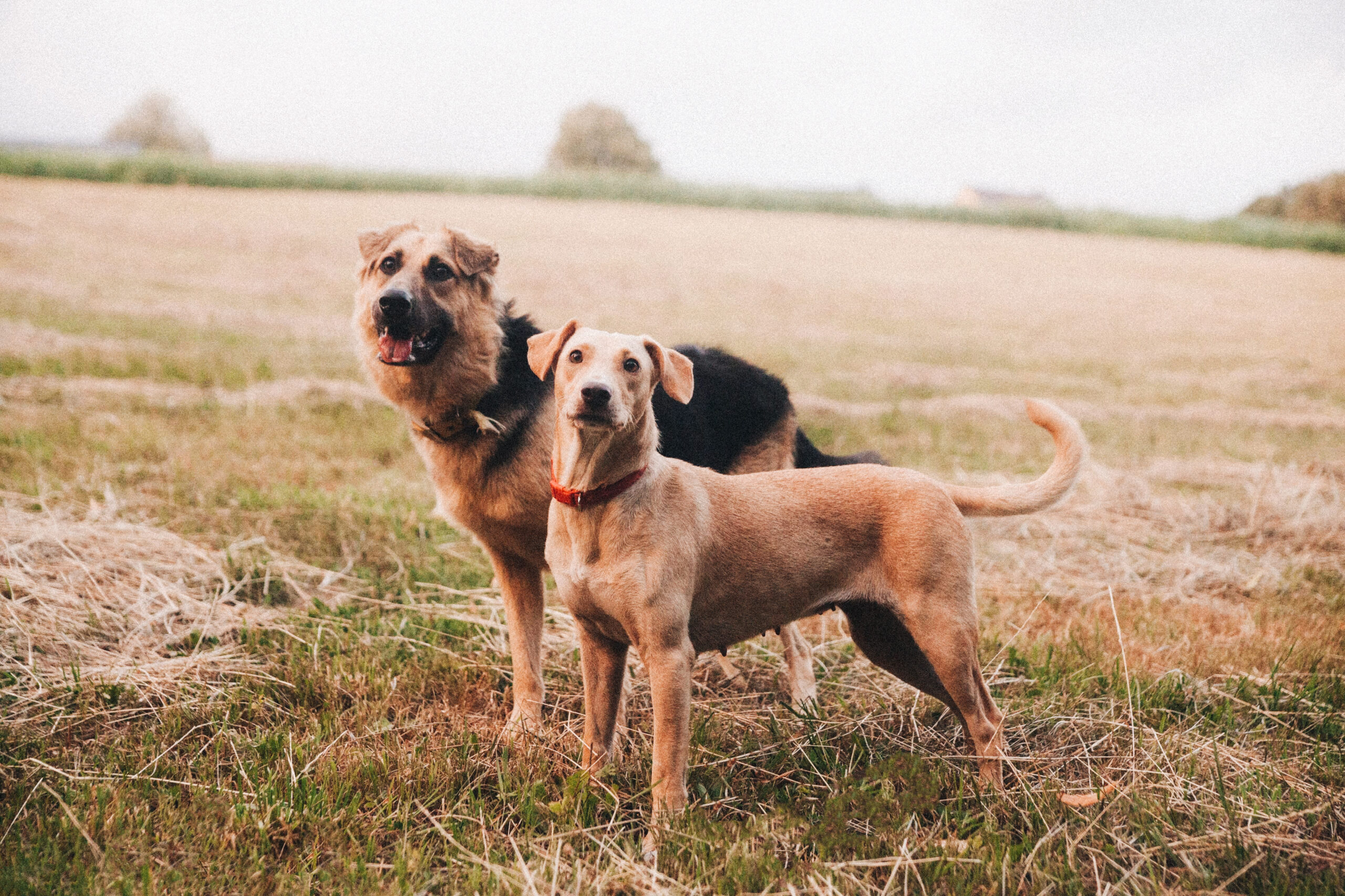
After diligently practicing commands and rules in our home forest, during week two, we planned our first small outing to a nearby walk in week three. Tia and Sandy did not know frequent driving and especially Sandy suffered terribly from nausea. When we opened the trunk of our car for the first time, both dogs were more than skeptical and didn’t want to get in.
We initially postponed our trip, to give them a week for getting used to the car. We wanted them to associate the trunk positively, without associating it with driving stress.
So, daily trunk opening, dogs in, praise, cuddle, treat, sit in together, have fun, dogs out. After a week, Tia and Sandy loved the trunk, jumped in on their own and relaxed inside.
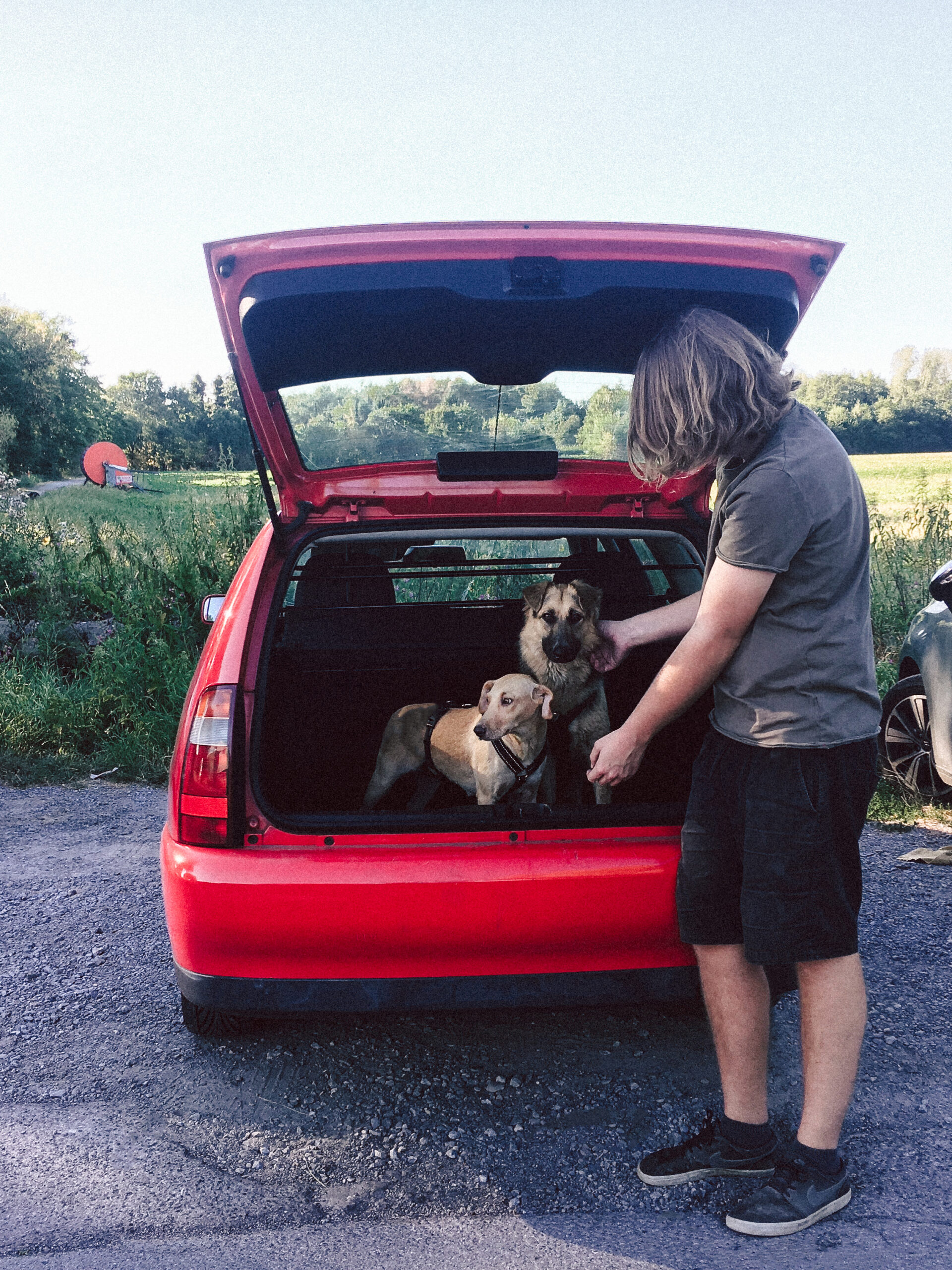
Now it was time for the first trip. We drove 5-10 minutes for a different walk every day, so they would get used to driving. We didn’t do longer laps until Sandy’s nausea on short distances had stopped.
The location change went off without a hitch. Tia and Sandy walked confidently and happily exploring the surroundings. I couldn’t help thinking how lucky we were with these two bitches. Especially Tia was not an easy character and needed a consistent leadership, but under this leadership, she showed herself extremely uncomplicated and well-behaved.



Both dogs brought the perfect prerequisites to become good travel companions, because they loved to get to know new walks, were adventurous and despite their traumatic past, brave and attentive.
By no means do I credit myself alone with this success. These two creatures made the greatest effort to implement what they had learned, to fit into the family and to control their negative impulses.
After the dogs had settled in so wonderfully, we started practicing being alone. Even though Tia and Sandy would rarely be left alone in the future, they need to be able to be, in case of an emergency or on shopping days.
As a general rule, we do not leave dogs alone, until their needs have been fulfilled. That means either after the morning walk and the following breakfast or after the big afternoon stroll and the following dinner. They are most relaxed when they are exhausted, full and tired.
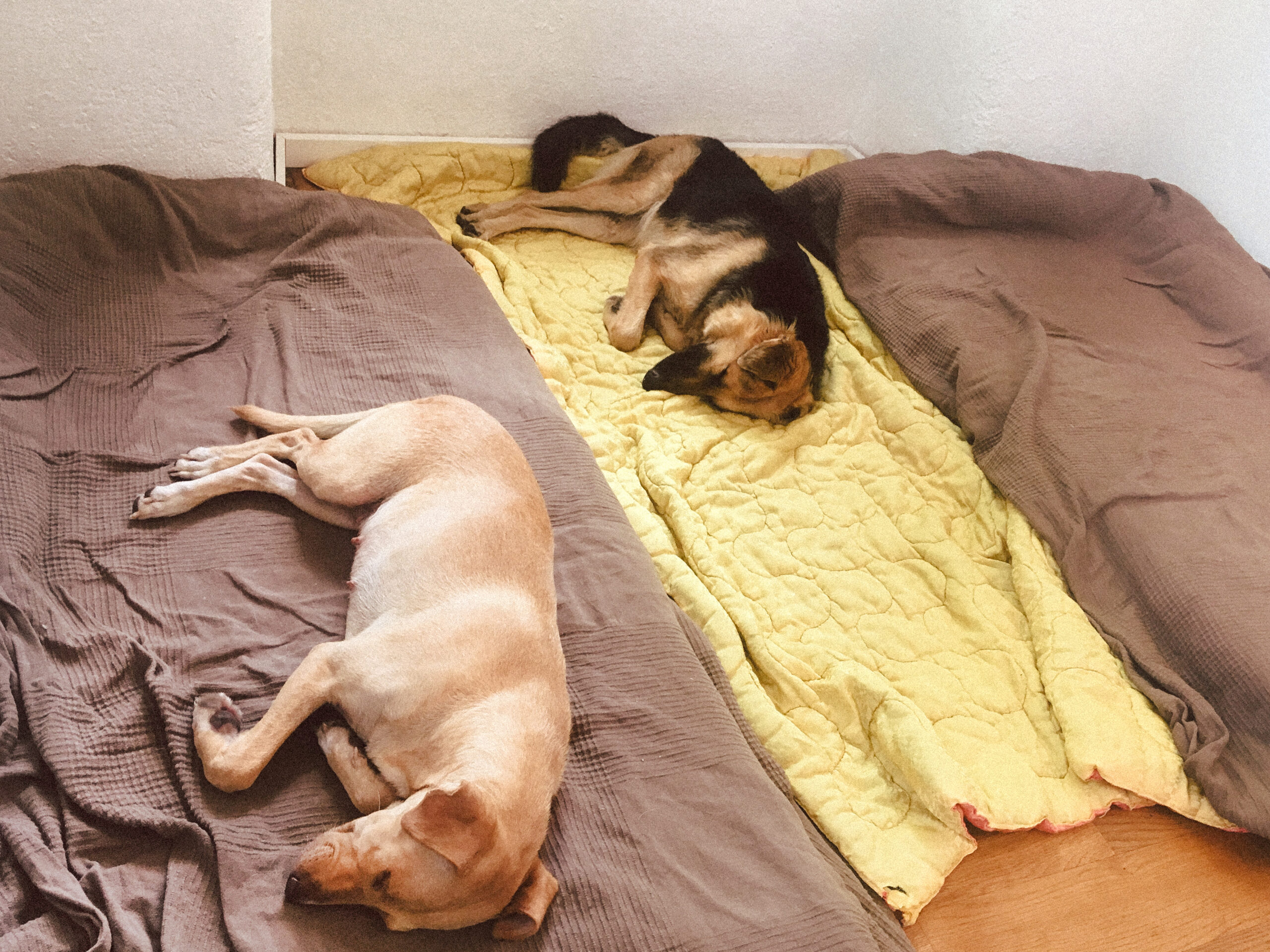
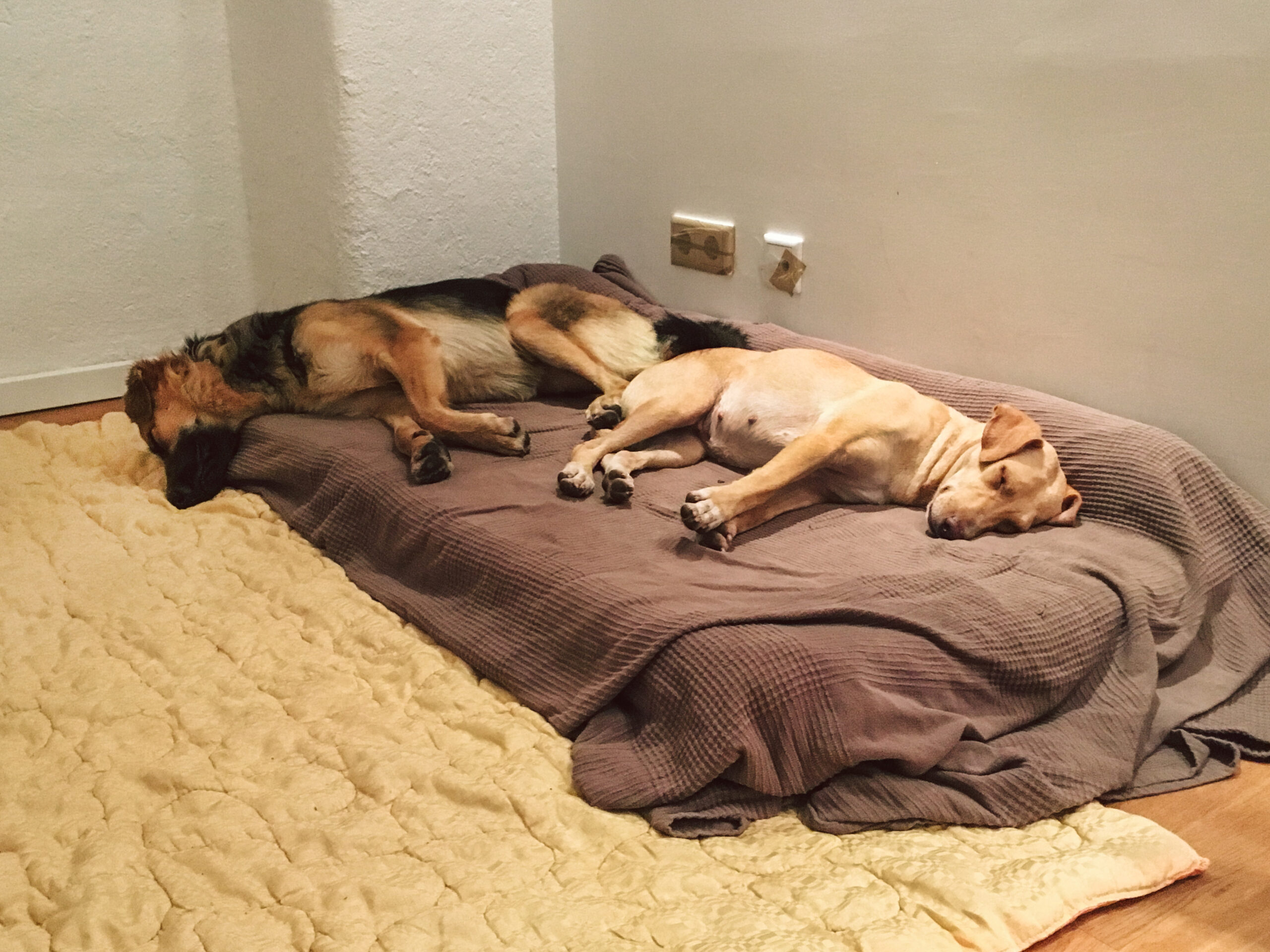
At first, we left the accommodation only for a few minutes during the day. If that worked well, we increased the time, minute by minute, until we left by car. Before leaving the house, we made sure the dogs were relaxed. We sent them to their beds, cuddled them a bit and then left without comment. Just as without comment, we came back.
Once again, we became aware of the luck we had with the two, because staying alone was never a problem for them. No matter if we were standing in front of the house for two minutes in the beginning or drove away for two hours to go shopping later. Together they mastered everything, without ever destroying anything or yapping the house down.
But not everything went completely smoothly.
There was one thing we did not practice, because it was not an everyday phenomenon in our apartment: The visit of unfamiliar people.
About three months after Tia and Sandy moved in, our landlady showed up at the door, to discuss our departure the following month.
Tia went completely nuts. She wasn’t just barking, she was screaming. She was fluffed up like a chicken, pinched her tail and hid under the kitchen table. She was in such a panic, that she was barely responsive.

We were a bit speechless, because she completely ignored strangers outside the house. She walked past screaming children, grabbing hands and quarreling couples, without a comment. Inside the house, however, she went into sheer hysterics. The landlady only stood in the hallway and did not even enter the apartment.
Now we knew about her obviously biggest problem and prepared ourselves accordingly for this reaction.
Since we hardly ever got visits from strangers, practicing was not easy.
Tia did not show any forward gait in these situations, but hid under the tables, communicating loudly.
We started practicing with ringing the front doorbell.
First, she had to learn not to panic.
She was allowed to report the bell. After she had reported, she should go to her bed and wait there. We managed the door.
However, she did not want to stay alone in bed with Sandy. My mother rang the bell, I answered the door, and Sören sat in bed with Tia, between her and the door, to shield her. Tia learned, that nothing happened to her in bed, because Sören was with her.
As soon as she understood it, Sören sat on the couch and Tia stayed in bed. Finally, Sören went with me to the door and Tia stayed in bed. We pretended to talk to someone at the door. She was alert, but no longer in panic.
We practiced in this manner, until she no longer paid significant attention to the door, but still without involving real strangers.
We knew that strangers were the problem, not the doorbell, so we asked our landlady to ring the doorbell and have a little chat with us. The whole procedure was repeated as Tia panicked and crawled under the table.
So: Sören and Tia in bed. Sören on the couch and Tia in bed. Sören and I at the door and Tia in bed.
We practiced with the parcel delivery man and the pizza delivery man. Basically all the delivery guys around. Always only at the door, because in the living room was the supreme discipline.
If someone entered the living room, we decided to leash Tia and keep her behind us. She should have the feeling of being led, but not involved or responsible for anything. In addition, we wanted to avoid her coming forward from under the table, teeth first. The basic rule for all foreign visitors was to ignore her completely. No peeking, no talking, no holding out hands. All this builds up pressure. She should be able to endure all this at some point, but now was not the time.
The landlady rang the doorbell. Tia announced and was send to bed. We went to the door to greet the landlady. Then, one of us went to Tia and leashed her, always positioned between Tia and the landlady. Tia growled and hissed, fidgeted with the leash and tried to sniff wildly at the landlady, but we forbade it with a stern tone and ordered her behind us.
When she is interested in someone, whether dog or human, she has to approach them slowly and in a friendly manner. Not hectic and snarling. We stood our ground talking and ignoring the dog, until she behaved calmly and sat down. She was praised, petted and then allowed to act out her cautious curiosity, sniffing the landlady.
Since Tia remained friendly, we unleashed her. Now the landlady was also allowed to say a few nice words to her. Tia began to be noticeably happy and even surprised us with a gift. She brought her ball to the landlady and showed a play face. Very carefully and gently, she invited the figure of her nightmares to play ball. Petting was still taboo, as was throwing objects, but this gesture touched us all.
Since the landlady as a figure had now lost terror, she could no longer serve as an exercise person. And so, we once used a lady who came to pick up something and a newly moved-in neighbor, who also had a dog.
The basics were now solidified.
Tia no longer panicked, but had learned other strategies and sequences to deal with her fear.
Honestly, I have to say that this problem persists, in a much calmer form, to this day. Tia finds strangers in the house just silly and scary. Unlike back then, however, she even approaches the strangers on her own, sniffs around a bit, growls and woofs, and then lies down somewhere.
Touching and harassing by strangers is still strictly forbidden and kept away from her, because she openly communicates, that she does not want that. Surely, the problem would be already further worked up, if there were more visitors. Visits, however, remain a rare commodity in our lives.
Sandy, by the way, does not answer the doorbell and is not interested in strangers inside her room. She stays in bed without communicating much. She is attentive. She also makes sure that everything is okay. She does not want to be touched by strangers either. However, she is much less reactive and doesn’t let herself get infected by Tia’s hysteria. She rather rolls her eyes and looks uncomprehendingly at the wall.
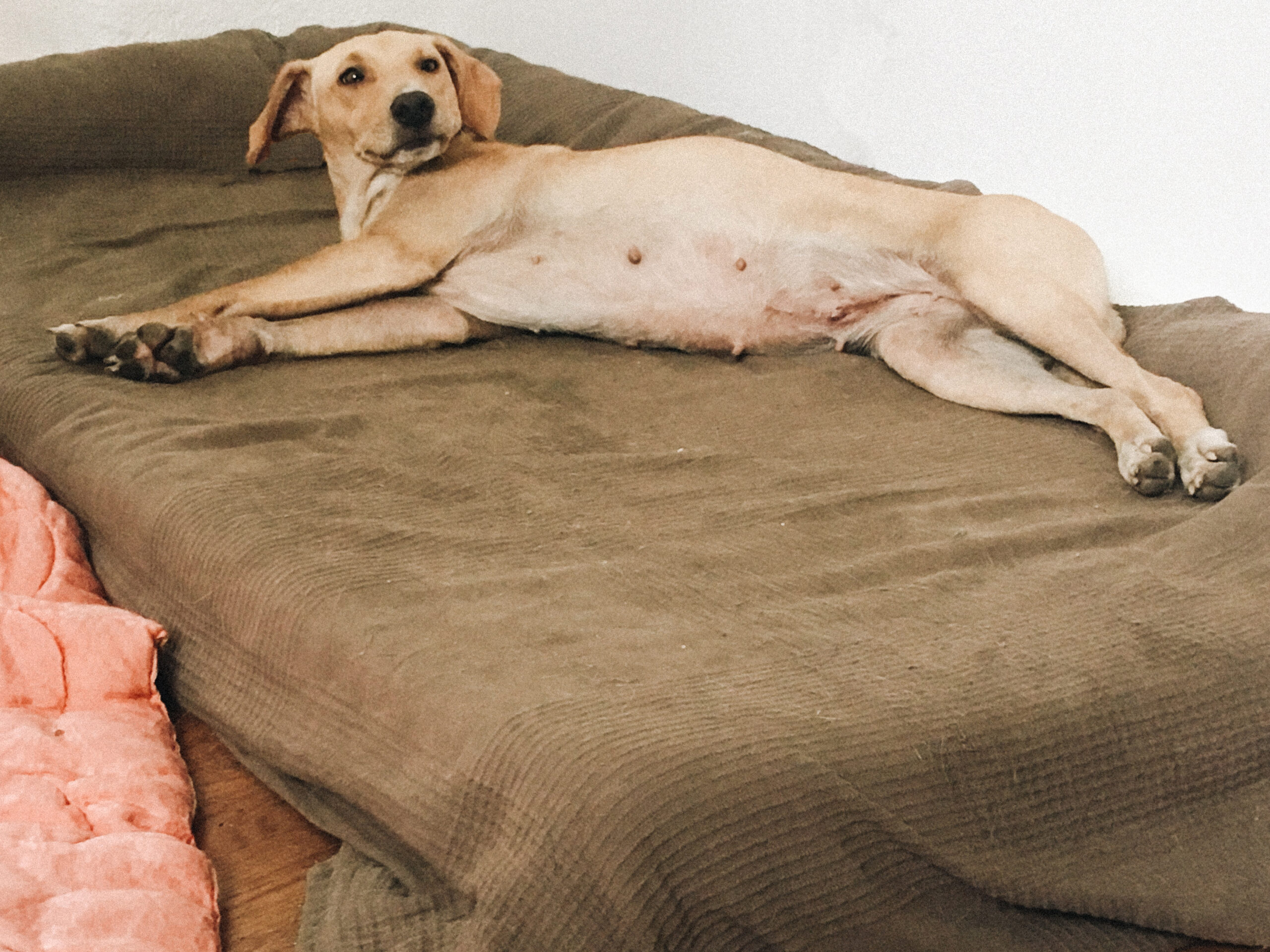
Tia’s drama around strangers in the house remains our biggest challenge to this day. Except for this problem, we actually have none with our dogs. However, with some procedures and set up rules, we can deal with it. If we can, we get to know the unknown visitor in front of the house and then go in together. This is the most pleasant option for Tia and fear reactions hardly occur.
In the five months that we lived in this home, we went on countless trips, practiced longer car rides, went swimming, visited markets, dog parks, city centers, other homes, and solidified our ground rules. Tia and Sandy did everything like two old hands, so detailed descriptions of all the trips are hardly worth mentioning.
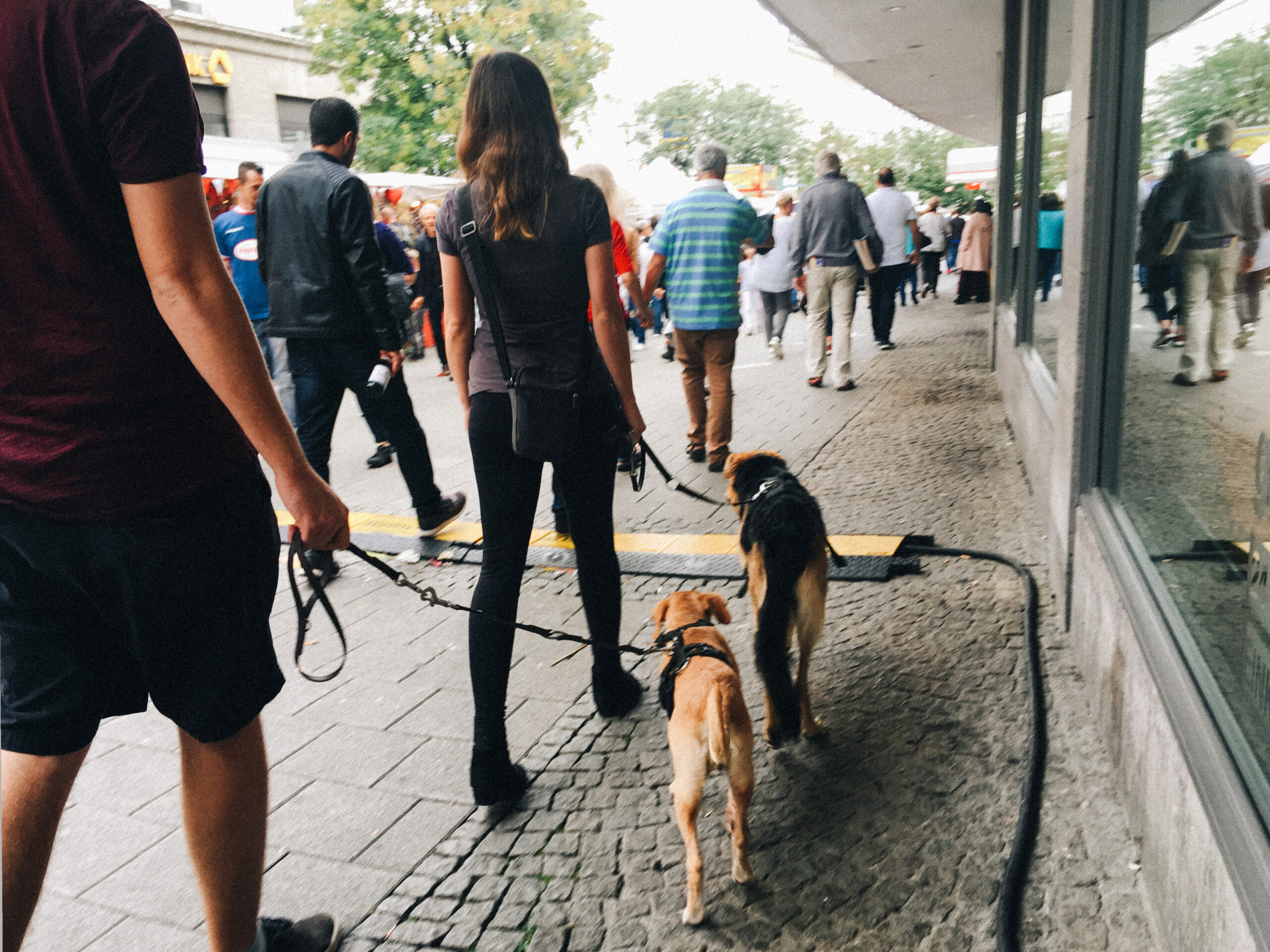
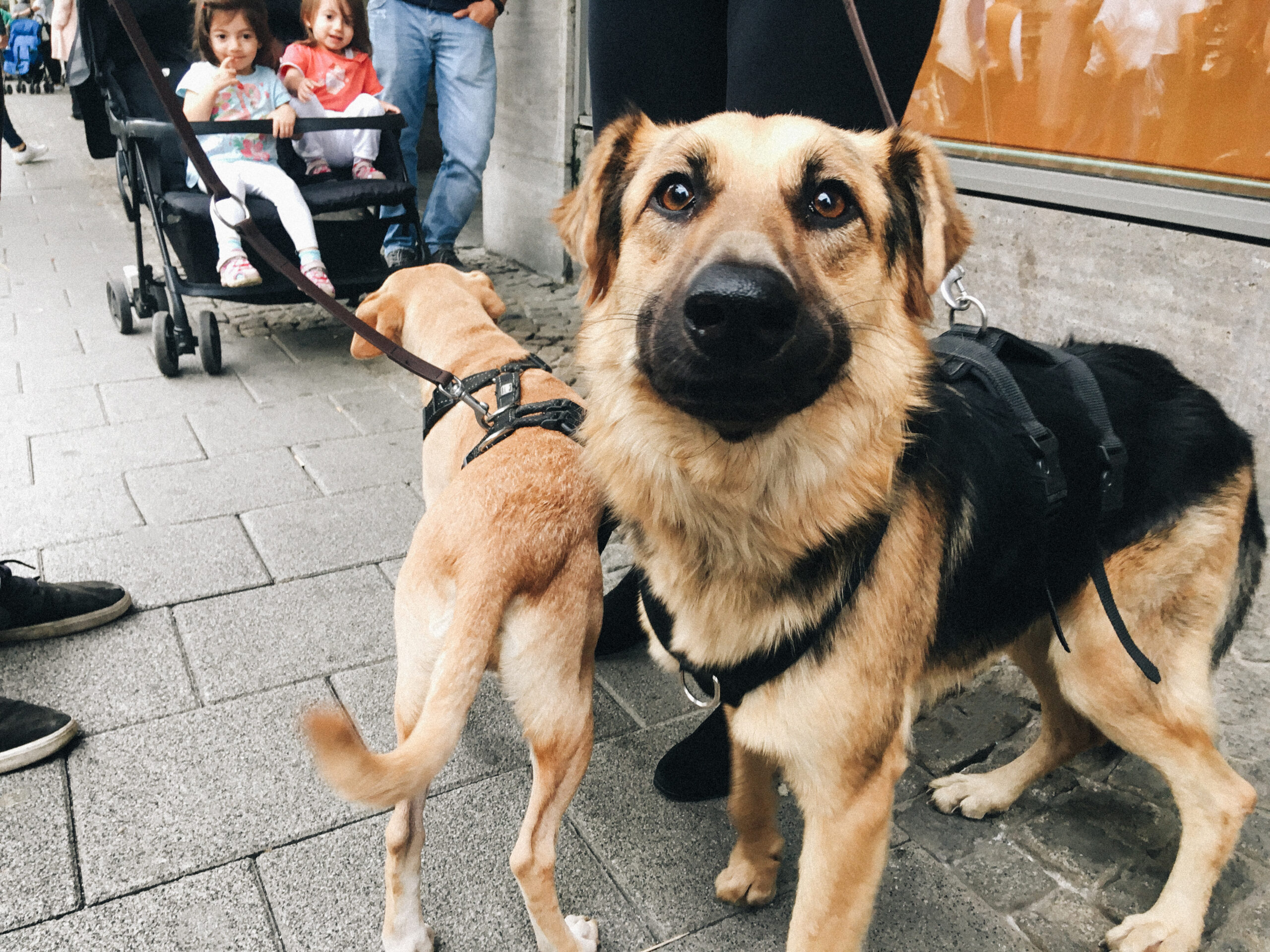
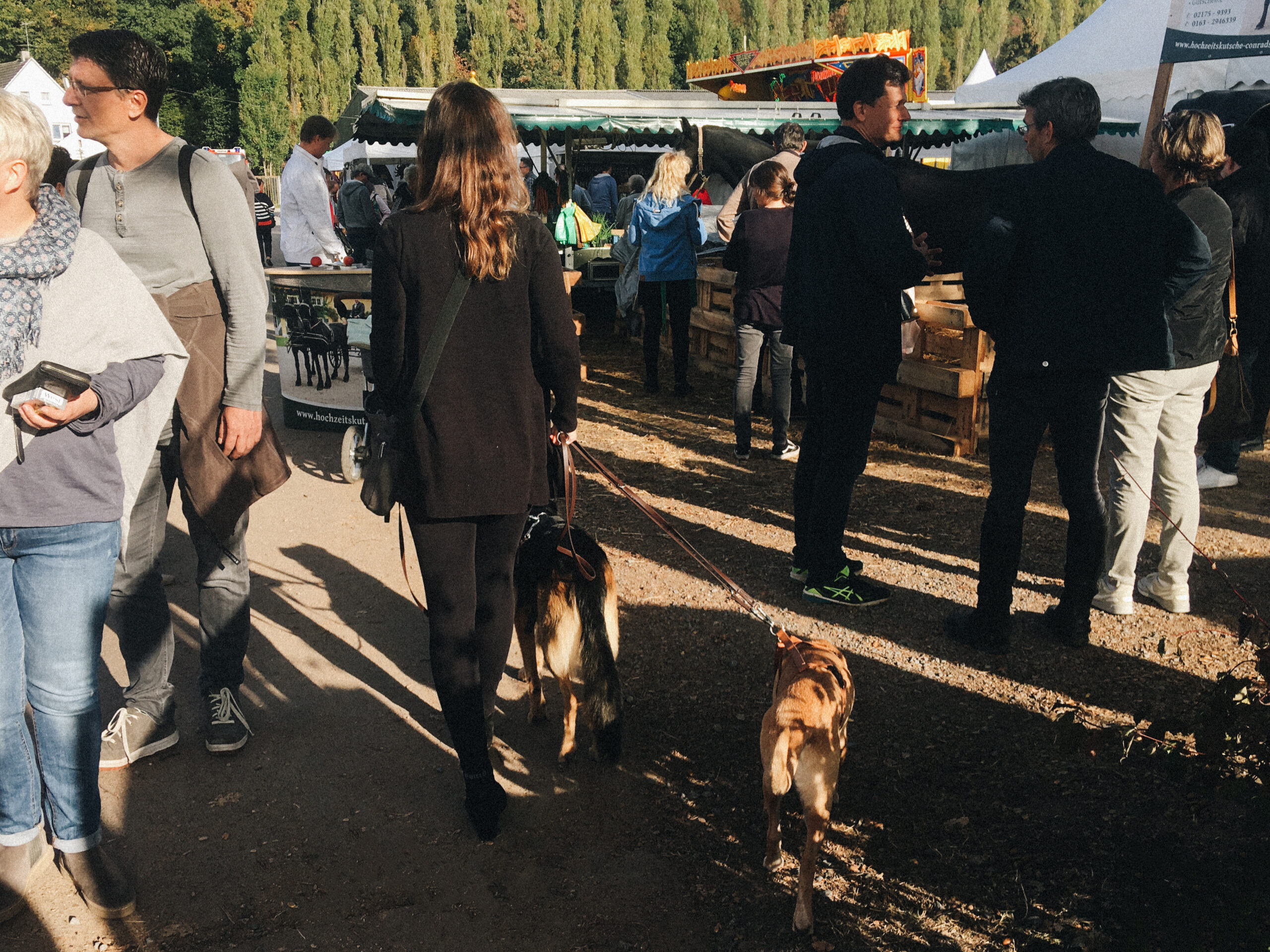
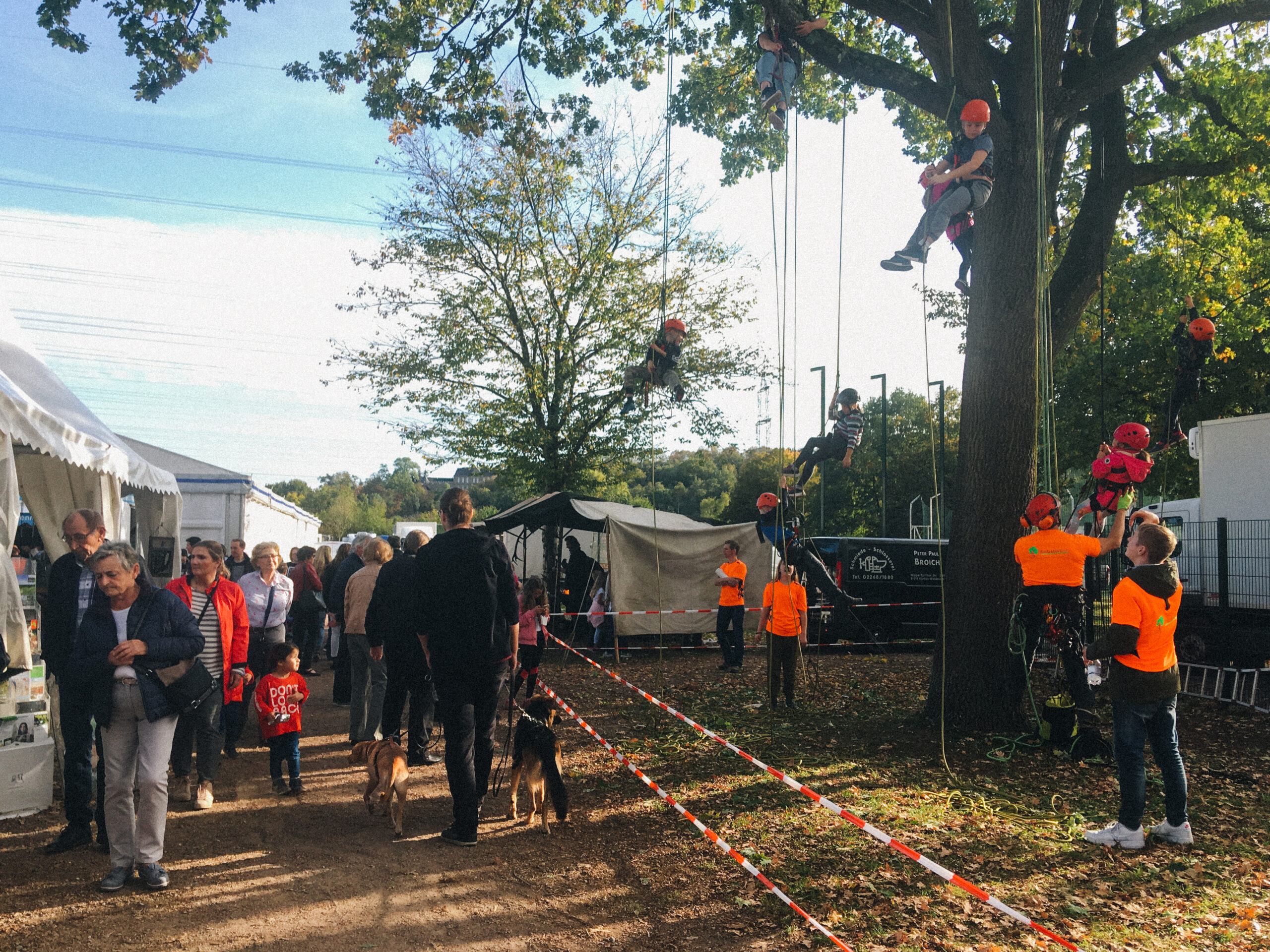
Visits to larger events remain a rarity to this day. Our dogs usually do not join visits to markets, big city or festivals, because it’s stress for four-legged friends and brings no value to their lives. Nevertheless, they should get to know it and be able to accept it, if necessary. Thus it must be practiced. The real daily life of our dogs, however, takes place in nature.
Check out he most beautiful pictures of our first trips to “Bergisches Land” in Germany here:
A clip of Tia and Sandy playing during their first days with us, can be found in the following video. The video shows very nicely how talkative Tia is. She is absolutely no barker, but a great chatterbox.



